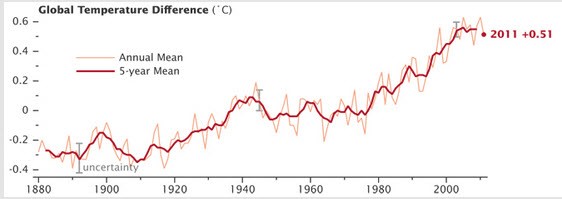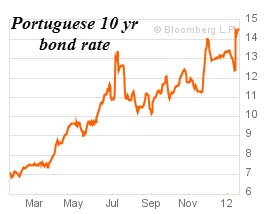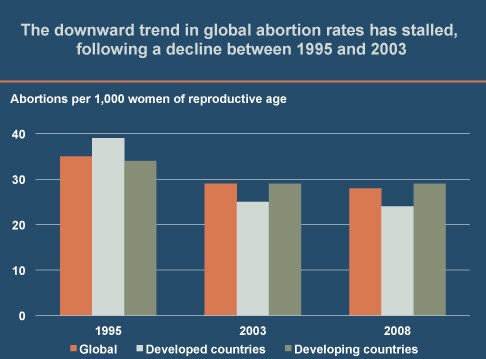Explanations of the hints at a slow down in global warming. NASA’s Goddard Institute for Space Studies (GISS) released overnight its analysis of world temperatures for 2011 including an attempt to explain an apparent slowdown in the rate of global warming.
It seems that 2011 was only the ninth warmest year in the GISS analysis of global temperature change, yet nine of the ten warmest years in the instrumental record (since 1880) have occurred in the 21st century.

The GISS summary of temperature trends and prospects concludes:
“The past year has been cooled by a moderately strong La Niña. The 5-year (60-month) running mean global temperature hints at a slowdown in the global warming rate during the past few years.
“However, the cool La Niña phase of the cyclically variable Southern Oscillation of tropical temperatures has been dominant in the past three years, and the deepest solar minimum in the period of satellite data occurred over the past half dozen years.
“We conclude that the slowdown of warming is likely to prove illusory, with more rapid warming appearing over the next few years.”
Full details of GISS’s answer to the question “Has Global Warming Slowed in the Past Decade?” are now on Crikey‘s The Stump website.
The biodiversity crisis: Worse than climate change. You can argue all you like about the Intergovernmental Panel on Climate Change but there’s now a new United Nations body setting out to prick our environmental consciences.
In Copenhagen this week what were described as “100 researchers and policy experts” from EU countries gathered to discuss how to organise the future UN Intergovernmental Panel for Biodiversity and Ecosystem Services, IPBES — an equivalent to the IPCC.
A statement after the meeting argued that species extinction and the degradation of ecosystems are proceeding rapidly and the pace is accelerating. The world is losing species at a rate that is 100 to 1000 times faster than the natural extinction rate.
“Mass extinctions of species have occurred five times previously in the history of the world — last time was 65 million years ago when the dinosaurs and many other species disappeared. Previous periods of mass extinction and ecosystem change were driven by global changes in climate and in atmospheric chemistry, impacts by asteroids and volcanism.
“Now we are in the 6th mass extinction event, which is a result of a competition for resources between one species on the planet — humans — and all others. The process towards extinction is mainly caused by habitat degradation, whose effect on biodiversity is worsened by the ongoing human-induced climate change.”
Conference organiser Professor Carsten Rahbek, Director for the Center for Macroecology, Evolution and Climate, University of Copenhagen, concluded:
“The biodiversity crisis — i.e. the rapid loss of species and the rapid degradation of ecosystems — is probably a greater threat than global climate change to the stability and prosperous future of mankind on Earth.
“There is a need for scientists, politicians and government authorities to closely collaborate if we are to solve this crisis. This makes the need to establish IPBES very urgent, which may happen at a UN meeting in Panama City in April.”
Now it’s Portugal’s turn. If you are getting bored with Greece and its economic problems, turn your mind to Portugal. It looks more and more likely to be the next cab off the bailout rank.

Some facts about abortion. A joint study by the World Health Organisation and the Guttmacher Institute of New York to be published this week in The Lancet has found that after a period of substantial decline, the global abortion rate has stalled.
The article Induced abortion: incidence and trends worldwide from 1995 to 2008 says:
- After declining substantially between 1995 and 2003, the worldwide abortion rate stalled between 2003 and 2008. Between 1995 and 2003, the global abortion rate dropped from 35 to 29. It remained virtually unchanged at 28 in 2008.

- In 2008, six million abortions were performed in developed countries and 38 million in developing countries, a disparity that largely reflects population distribution.
- Globally, the proportion of abortions that take place in the developing world increased between 1995 and 2008, from 78% to 86%, in part because the proportion of all women who live in the developing world increased during this period.
- Nearly half of all abortions worldwide are unsafe, and nearly all unsafe abortions occur in developing countries. In the developing world, 56% of all abortions are unsafe, compared with 6% in the developed world.
- Highly restrictive abortion laws are not associated with lower abortion rates. For example, the abortion rate is high, at 29 and 32 abortions per 1000 women of childbearing age in Africa and Latin America, respectively — regions where abortion is illegal under most circumstances in the majority of countries. In Western Europe, where abortion is generally permitted on broad grounds, the abortion rate is 12 per 1000.
- Where abortion is legal on broad grounds, it is generally safe, and where it is illegal in most circumstances, it is generally unsafe. For example, in the United States, where abortion is legal on broad grounds, induced abortion results in 0.6 deaths per 100,000 procedures. In Latin America and Sub-Saharan Africa, abortion results in 30 and 460 deaths per 100,000 procedures, respectively.
- Each year 47,000 women die as a result of unsafe abortion, accounting for 13% of all maternal deaths worldwide. Almost all of these deaths occur in developing countries.







Careful Crik ey, you will put the Cash For Comments Scientists out of business.
Like the one who lives on the waterfront at Coba Point on the Hawkesbury.
If the science is settled why aren’t the warmists demanding we cut all government funding for climate change research? Where’s the sense in wasting our taxes flogging a dead horse?
@ Patriot
Great point. The answer is cause its their income, comes easy
@Patriot Obviously there is plenty more to understand about this issue moron.
So the science isn’t settled after all. How about that.